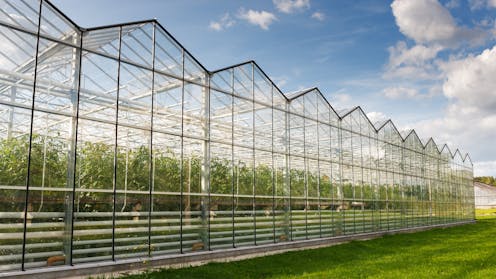Why burning waste to power a giant greenhouse really could be a greener way of growing food
Tomatoes could be grown at an industrial scale using heat generated from burning household waste in Essex, UK. Jenoche/Shutterstock
A new project in Bradwell, Essex, aims to change how we grow food and how we deal with our rubbish. Slated to begin operations in 2027, the Rivenhall greenhouse project could become Europe’s largest low-carbon horticulture facility.
While smaller scale applications already exist, primarily in the Netherlands, a proposal of this size is ambitious: to use heat from waste incineration to power and warm a massive 40-hectare greenhouse to produce up to 30,000 tonnes of tomatoes a year (around 6% of the UK’s current consumption).
The idea is to close two loops at once. By processing most of Essex’s household waste, the region’s reliance on landfill can be reduced – this cuts the amount of biodegradable waste decomposing to release methane (a greenhouse gas far more potent than carbon dioxide). Also, by diverting the energy from that waste to grow food locally, less produce will need to be imported from regions increasingly vulnerable to climate-related stresses like drought and water scarcity.
The giant greenhouse will sit next to the Rivenhall integrated waste management facility, operated by waste company Indaver. Household waste will be incinerated on site, producing steam. Some of that steam will drive turbines to generate electricity and power the greenhouse. The rest of the steam will heat the greenhouse at a constant temperature all year round.
Get your news from actual experts, straight to your inbox. Sign up to our daily newsletter to receive all The Conversation UK’s latest coverage of news and research, from politics and business to the arts and sciences.
To further reduce greenhouse gas emissions, a carbon capture system (separates CO₂ from other gases in exhaust streams) will extract around 20,000 tonnes of carbon dioxide annually from the incinerator’s flue gases. Rather than releasing this into the atmosphere, the captured carbon dioxide will be piped into the greenhouse to enhance plant growth.
Still, the scale of carbon capture is modest and not a quick fix. The 20,000 tonnes of carbon dioxide expected to be captured annually represents less than 10% of typical emissions from similar-scale waste facilities.
The facility will include 13 hectares of artificially lit greenhouse space for winter growing and a vertical farm (growing crops in stacked layers) converted from a former RAF hangar to grow leafy greens. In theory, this creates a resilient, year-round food production system largely decoupled from fossil fuels and climate-sensitive imports.
Burning waste to grow tomatoes might sound counterintuitive. Incinerators still release emissions after all. As a method of electricity generation, incineration of waste has a higher carbon footprint than burning coal. But in the context of current waste management and food import practices, it may make sense.
According to the UK government’s Department for Environment Food and Rural Affairs, around 30.8% of England’s household waste went to landfill in 2023 (around 8 million tonnes). Landfill emissions (primarily methane) are not just large – they’re long-lived and hard to capture.
A modern waste incineration plant.
Below the Sky/Shutterstock
Rivenhall’s model claims to reduce total greenhouse gas emissions by roughly 20% compared to landfill. When electricity, heat, and food outputs are factored in, and carbon capture included, emissions per kilogram of tomato could be substantially lower than those from conventional imports or fossil-powered greenhouses.
But low-carbon status is not a badge that companies claim, it’s a result that needs to be verified. In lifecycle assessment (a method for measuring the environmental impacts of a product, service, or system, and the focus of my research), low-carbon status only applies if net emissions per kilogram of tomato are demonstrably lower than those from the realistic baseline.
That baseline, be it landfill, composting, anaerobic digestion, or recycling, must be clearly defined. If incinerated waste includes material better suited to recycling, the claimed benefits narrow or vanish.
The success of this particular project hinges not just on technical integration, but on accurate emissions accounting and efficient performance of carbon capture systems.
According to the waste hierarchy, the most sustainable strategy for reducing waste-related emissions is not incineration, but waste prevention and reduction. Energy recovery is better than landfill, but less preferable than eliminating waste altogether.
The bigger picture
In the Netherlands, greenhouses often run on combined heat and power systems. In Canada, some horticultural operations use industrial waste heat. But Rivenhall’s scale and its tight integration with waste management infrastructure makes it unusual. If it works, it could serve as a blueprint for how regions can simultaneously tackle food security and waste while keeping the environmental cost of consumption closer to home.
Beyond greenhouse gas emissions, there are other environmental considerations. Even modern incinerators produce air-polluting nitrogen oxides and particulates, which must be rigorously controlled to avoid human health problems such as lung disease. To comply with the UK’s biodiversity net gain rules, natural habitats and wildlife populations around this site must be enhanced, not degraded.
While delivering on its technical promises, Rivenhall must also prove that its low-carbon credentials are more than just hot air. Even so, projects like this are no substitute for upstream solutions like waste prevention, reduced consumption and circular design.
Don’t have time to read about climate change as much as you’d like?
Get a weekly roundup in your inbox instead. Every Wednesday, The Conversation’s environment editor writes Imagine, a short email that goes a little deeper into just one climate issue. Join the 45,000+ readers who’ve subscribed so far.
Alex Newman does not work for, consult, own shares in or receive funding from any company or organisation that would benefit from this article, and has disclosed no relevant affiliations beyond their academic appointment.



